Springs – Our most precious water resources also provide great recreation opportunities
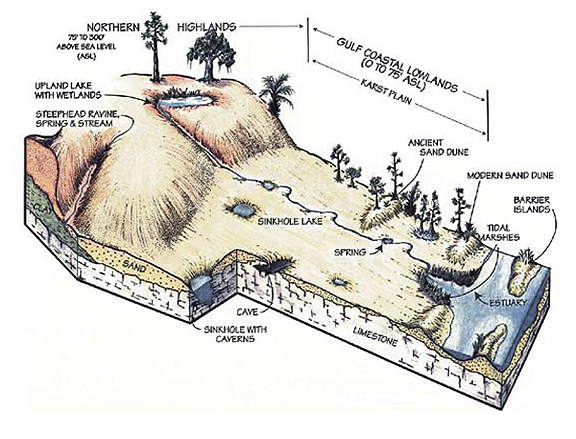
Some of the most beautiful places to explore Northwest Florida are along our spring fed waterways. These creeks, streams and rivers provide incredible recreation and eco tourism along with the valuable drinking water our communities rely on.
Florida boasts more than 1,00 springs, with close to 40 in the Walton, Holmes, Washington and Bay counties, with 13 springs feeding in the Choctawhatchee River basin. The Gainer Springs Group on Econfina Creek (including springs locally known as McCormick and Emerald) is the most significant, measuring a first magnitude flow of 114 million gallons a day (mgd). Econfina creek feeds into Deer Point Lake which is the major source of water supply for Bay County.
What are springs?
Springs are portals where water in the earth’s aquifers, rises to the surface and escapes into our streams, lakes and coastal waters. There are two general types of springs in Florida, seeps (water-table springs) and karst springs (artesian springs). The springs in Northwest Florida are karst springs. Karst topography is a landscape created by groundwater dissolving into sedimentary rock such as limestone. This creates landforms such as shafts, tunnels, caves, and sinkholes. The Dougherty Karst Plain underlies our area.
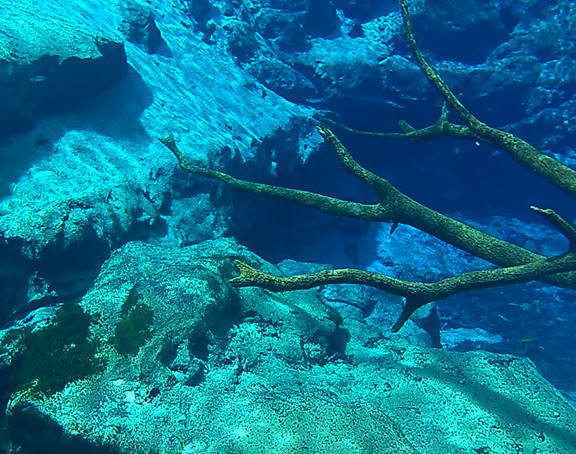
What is a spring classification?
Springs are most often classified based upon the average discharge of water. Individual springs exhibit variable discharge depending upon rainfall, recharge and groundwater withdrawals within their recharge areas. One discharge measurement is enough to place a spring into one of the eight magnitude categories. However, springs have dynamic flows. A spring categorized as being a first-magnitude spring at one moment in time may not continue to remain in the same category. This can result in a spring being classified as a first magnitude spring at one point in time and a second magnitude at another.
What will I find exploring a spring and a spring fed waterway?
These beautiful waterways of Northwest Florida are abundant with fish and plant life.
Here is a list of the most common things you will find:
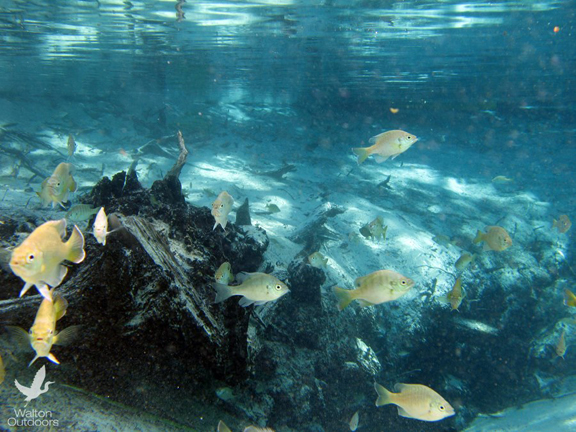
Fish:
Largemouth bass, spotted bass, bluegill, sunfish (shellcracker), redbreast sunfish, warmouth, black crappie, striped bass, catfish, alligator gar, bowfin.
Invertebrates:
Florida Apple snail, freshwater mussel, pond crayfish, six-spotted fishing spider, mayfly, diving beetle, giant waterbug, dragonfly, damselfly, mosquito, biting fly, butterfly.
Reptiles:
Florida green water snake, cottonmouth/water moccasin, Florida snapping turtle, American alligator, salamanders, newts, treefrogs.
Mammals:
Gray squirrel, river otter, beaver, raccoon
Birds:
Wood duck, mottled duck, great blue heron, great white heron, green heron, ibis, swallow-tailed kite, bald eagle, hawk, owls, osprey, kingfisher, warbler, scarlet tanager.

Trees/Plants/Grasses:
Bald cypress, live oak, red maple, pawpaw, black titi, red titi, Cherokee bean, sweetbay, blackgum, juniper, red cedar, southern magnolia, laurel oak, tupelo, hickory, willow, wax myrtle, cabbage palm, saw palmetto blueberry, hydrangea, St. John’s wort, mountain laurel, water lily, pickerelweed, pitcher plant, broad leaved arrowhead, fern, moss
Where can I find a spring fed waterways to explore?
There are almost endless possibilities of places to explore in a kayak or a canoe. Here are four of the best places to launch or rent a kayak or canoe, or enjoy swimming in the cool water of a spring fed wateray.
Here is a Lat. Lon listing of springs in Walton, Holmes, Washington and Bay counties: springlocationlist
________________________________________________________
Vortex Spring in Ponce DeLeon
ACCESS BY VEHICLE. There is a sure cure for the summertime heat just north of Hwy. 90 in Ponce De Leon. Vortex Spring Adventures offers an adventurer cave diving, swimming, and family-oriented year-round fun, including crystal clear dives into a deep limestone cavern. W 28 million gallons of water daily at a year-round temperature of 68 degrees. Just north of U.S. Hwy. 90 on SR 81 in Ponce De Leon you will discover a great place to chill out on a hot summer day.
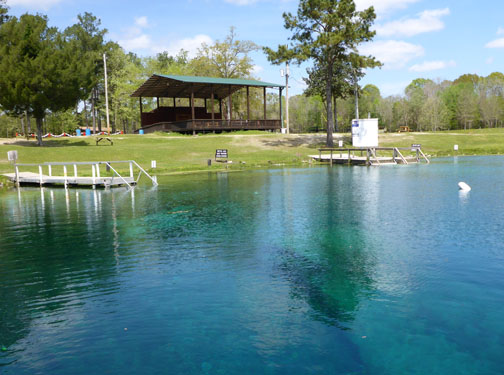
A popular dive and recreational spot since the mid 1970s, Ruth and Denzel “Doc” Dockery, the creators of the “diver down” flag were the original owners of Vortex. The park is now owned by their son Daryl and his wife Angela Dockery.
The recreation area is popular spot for swimmers during the warm weather months. A diving board, high jump platforms, slides, and a rope swing provide fun-filled launches into the cool spring water. Picnic tables with grills, and grassy areas along the spring run offer opportunities for a fun-filled day in several areas. A dive shop with everything you would need including suits, masks, gauges, snorkels, water toys, and even a children’s line of clothing are available for the water explorer. Several SCUBA certification classes are offered at Vortex year round. Click here for info.
A variety of lodging accommodations are available at Vortex, including a large home for divers, corporate retreats, or private events which hosts up to 24 people. Additional lodging includes bunk-bed lodges, rooms with queen beds and kitchenettes, cabins, and campsites with electrical hookups. Water and sewer is available at some of the sites, along with a dump station available on site. Day camping is also available.
Big plans are in the works as the Dockerys continue to expand their more than 500-acres and make Vortex Spring Adventures a more family-oriented destination. In addition to new cabins, campsites, and a wedding venue barn in the works, the couple plans to facilitate two multi-acre open fields; one 30-acre area and one 57-acre area into event venues. Trail improvements are also in the works.

Hours of Operation
Summer: Monday – Thursday 8 a.m. – 7 p.m., Friday – Sat. 7 a.m. – 8 p.m., Sunday 7 a.m. – 6 p.m.
Winter: Monday – Thursday 8 a.m. – 4 p.m., Friday – Sat. 8 a.m. – 5 p.m., Sunday 8 a.m. – 5 p.m.
Diving fees are $25.00/day for certified full cave diver or equivalent, all other divers $25.00. A full line of scuba rental gear is available including nitrox air. Click here for details.
Swimming 13 and up is $15.00/day, children age 5-12 $10.00, children 4 and under free. If you wish to upgrade to the basin dive area, it is an additional $6.00.
Tubes, snorkeling gear, canoes, kayaks, and paddle boards are available for rent.
Vortex Spring Adventures, 1517 Vortex Springs Lane, Ponce de Leon, FL, 32455. Tel: (850) 836-4979.
________________________________________________________
Econfina Creek in Washington and Bay County
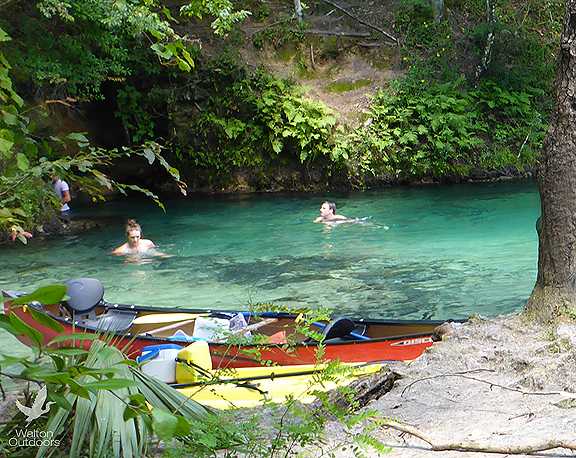
ACCESS BY PADDLING. Part of Florida’s Greenways and Trails, the Econfina Creek in Bay and Washington counties is many a paddlers’ favorite journey in the Florida Panhandle.
Pack a lunch and bring your snorkel, for you are about the enjoy the paddle of a lifetime as you explore the creek and its many crystal clear springs along the popular seven-mile trip down the creek. Cabbage palms drape over the water’s edge along with blooming wildflowers scattering the banks with color during your journey in the spring and summer months. Steep, fern-covered limestone walls prevail along the second half of the paddle, where the creek slices into the ancient limestone of the Floridan Aquifer.
The northern portions of the creek are difficult with many logjams and shallow water. Most paddlers opt to put in at the Econfina Livery as the livery offers the option of pick up and return at the take out at SR 388 bridge. They also have kayaks and canoes available for rent.
The Econfina Creek is largely preserved and managed by the Northwest Florida Water Management District, and part of the much larger 41,000 acre Econfina Creek Water Management Recreation Area. The Recreation Area offers camping, hiking along the Florida Scenic Trail, boating, fishing and equestrian trails along with campsites and recreational parks.
The District has identified 11 springs or spring groups comprised of 39 individual vents, most of them within a mile of State Road 20.
There are several places to launch a canoe or kayak:
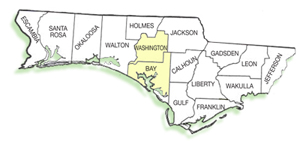
• SR 20 Bridge – (1 mile) limited parking.
• SR 388 Bridge – (6 miles)
________________________________________________________
Swim, picnic and enjoy nature at Pitt and Sylvan springs Recreation Area along Econfina Creek
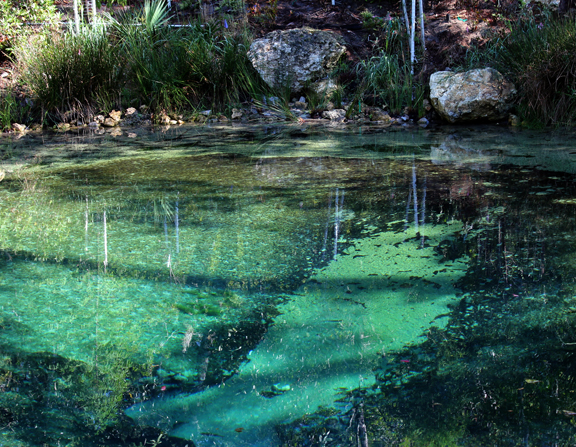 ACCESS BY VEHICLE. Looking for a place to take a dip in a spring and grill a few dogs and burgers? Head over to the newly renovated Pitt and Sylvan Springs and enjoy a day nestled in nature along Econfina Creek.
ACCESS BY VEHICLE. Looking for a place to take a dip in a spring and grill a few dogs and burgers? Head over to the newly renovated Pitt and Sylvan Springs and enjoy a day nestled in nature along Econfina Creek.
Located along State Road 20 in Bay County, this public recreation area recently went through major restoration by Northwest Florida Water Management District. The endeavor was the first phase of the District’s Econfina Springs Complex – Spring Restoration and Protection Project.
The project for the 10-acre park was a long process, with initial planning beginning in 2006. Heavily eroded creek banks were restored with root balls and water friendly trees such as wax myrtle and Carolina willow were placed to prevent future erosion.
The main park area improvements include easier access to Pitt Spring, three pavilions with picnic tables, grills, and boardwalk trails through the park to the Sylvan Springs over look area. There you can easily view the tiny spring boils bubble up through the limestone.
Colorful interpretive signs educate the nature lover on the boardwalk trails. An improved canoe dock on Econfina Creek was added, along with a tube launch dock near Sylvan Spring run confluence to the creek. Depending on the water levels, these dock areas can be tricky to access by canoe or kayak.
The park is open from sunrise to sunset. There are no lifeguards on duty. No pets allowed except service dogs. There is ADA access to most of the park and an environmentally friendly self-composting rest room facility has been installed as well.
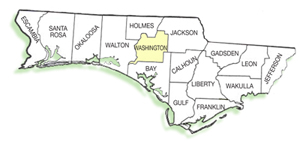
Washington county.
There are no kayak, canoe or tube rentals available at the recreation area, however there is a rental livery located off of Strickland Road: Click here for info.
Entrance to the park can be made from either State Road 20 or Strickland Road. ::MAP::
Location: Bay County–Lat. 30° 25’ 58.68” N., Long. 85° 32’ 47.14” W.
________________________________________________________
Williford Spring on Econfina Creek a cool family destination
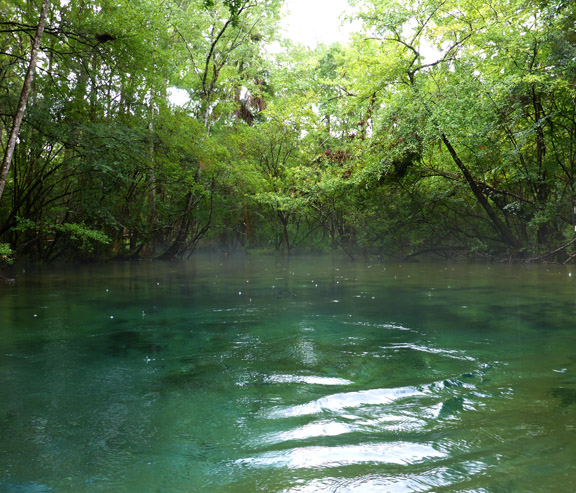
ACCESS BY VEHICLE. The Northwest Florida Water Management District has completed restorations of Williford Spring in southern Washington County, Florida.
The $1.52 million project improved water quality and protected the shoreline of Williford Spring. Recreational enhancements include spring entry steps, patio terrace, spring view deck, canoe dock, boardwalks, composting toilets, picnic pavilions, parking area, a connector trail to Pitt and Sylvan springs, as well as interpretative trails and native landscaping throughout the site.
Williford Spring is located in the Econfina Creek Water Management Area between SR 77 and U.S. 231 off of Herman Strickland/Porter Pond Road. ::MAP::
About Williford spring:
Williford Spring has a circular spring pool in a conical depression whose sand bottom is rippled by issuing spring currents. The pool measures 57 ft. in diameter. The vent is under a limestone ledge roughly in the center of the pool, and the depth measured over the vent is 10.1 ft. There is a sizable boil over the vent, and the color of the water is light blue-green. There is no aquatic vegetation in the pool, and a thin layer of algae covers less than half of the limestone and sand substrates. Williford Spring discharges through a swiftly flowing spring run that travels south for approximately 443 ft.into Econfina Creek.

There are numerous other smaller springs that feed into Williford Spring run immediately downstream. Some of these springs are small trickles from limestone fissures exposed along the banks of the run. To the north and west of Williford Spring, high ground rises to approximately 15 feet above the water surface. A lowland forest of hardwoods, cypress and palms hug the spring and its run. The surrounding rolling sand hills terrain supports mixed hardwood and pine uplands.
________________________________________________________
Blue Spring on Econfina Creek
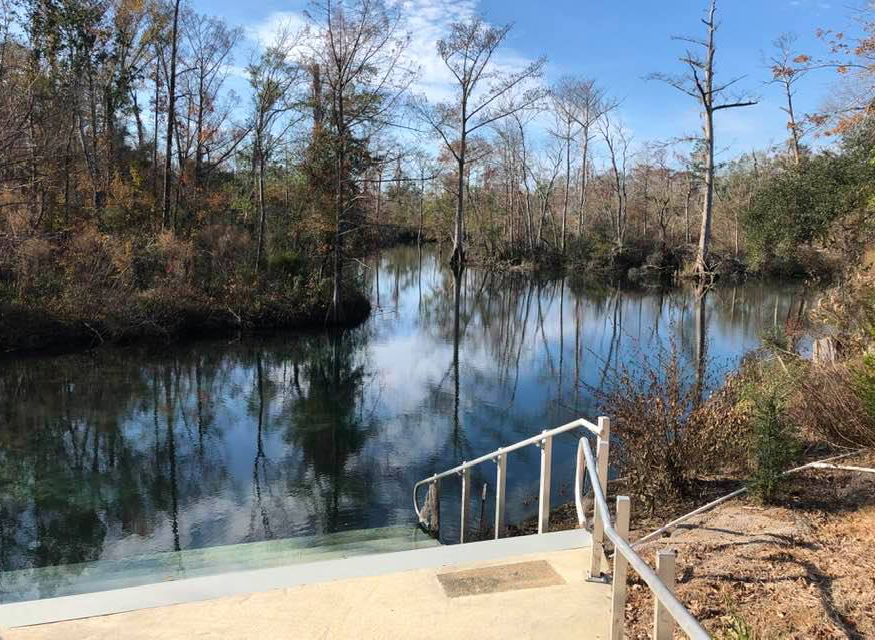
ACCESS BY VEHICLE BY PADDLE: Located approximately 1.5 miles north of State Road 20 and accessed off Blue Springs Road North in Youngstown, the Blue Spring recreation area on Econfina Creek has several new features. Recently restructured after a devastating Hurricane Michael, the recreation area now consists of an ADA-compliant ramp and stair access to the spring, an overlook deck of the spring vent, and a pedestrian bridge overlooking a separate karst feature. Visitors can also enjoy picnic pavilions, a pedestal grill, fire ring, and portable toilet.
Three individual campsites are available for use by reservation only adjacent to the recreation area. The Blue Spring camping area is accessed through the first entrance to the site on Blue Springs Road. The day use area is accessed through the second entrance on Blue Springs Road. The primitive campsite areas have grills, pavilions, and an ADA portable toilet. Make camping reservations through Northwest Florida Water Management here.
Blue Spring is one of 11 springs or spring groups, comprised of at least 39 vents, located along the Econfina Creek basin. Blue Spring features three spring vents, and the combined flow classifies the group as a third magnitude spring (flow between 1 and 10 cubic feet per second). Flow from Blue Spring and the other springs along Econfina Creek ultimately discharge into Deer Point Lake, which is the primary source of drinking water for residents of Bay County.
Day-use is allowed from 8 a.m. to sunset. Parking is limited.
Location: 5247-5273 Blue Springs Rd., Youngstown, FL. Latitude/Longitude: 30.453238, -85.529542
::MAP::
Blue Spring is located off of SR20 on North Blue Springs Road, Youngstown.
________________________________________________________
Holmes Creek in Washington County
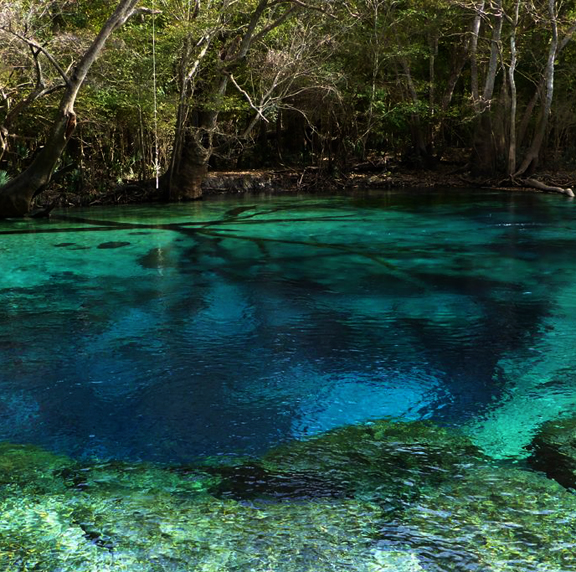
ACCESS BY PADDLING. As part of Florida’s statewide system of Greenways and Trails, Holmes Creek flows through a variety of diverse habitats. The upper and lower portions pass high sandy banks while the majority of the tail is through low-lying swamplands.
Rich with flora and fauna, the creek is abundant with turtles and birds, including blue, green and white heron, ibis, warblers and woodpeckers.
Several sections of the creek are shallow and clear. Underwater plants seem alive with movement as they ripple under the water’s surface. Water lilies are in abundance, and on this mid-summer day, were just starting to bloom.
Bird and wasp nests dangled from the trees seemed almost as though suspended in air as you looked above towards the treetop’s canopies.
There are several crystal clear springs, including Cypress Springs, which flows at 89 million gallons per day and Becton Springs, which flows at 40 million gallons per day, that feed the creek. There is a smaller spring at the Brunson landing where you can pull in, take a short walk along a wooded trail and find the small spring approximately 35 ft. in diameter.
Bring your snorkeling gear, as a dive into Cypress Springs is one of the highlights of the paddle offering you the opportunity to get up close and personal with a beautiful spring boil.
The creek has many low-hanging branches and submerged tree trunks, which can present a small, but not difficult challenge. For the most part, the gentle curves and a slow current make Holmes Creek an easy paddle through beautiful hardwood swamps.
Canoe liveries:
Cypress Springs Adventures – Kayaks, canoes, and stand up paddle boards
3324 Highway 277
Vernon, FL. 32462
(850) 535-2004 – map
Holmes Creek Canoe Livery – Kayaks and canoes map
Located at SR 79 North of the Vernon Bridge. 850-210-7001

Launches:
• Mile 0—Burnt Sock Landing: Located off of Johnson Road north of Vernon. Latitude/Longitude: 30.67903, -85.66397
Cotton Landing: 3 miles north of Vernon on CR 277. This managed by Northwest Water Management District with primitive camping allowed. There is a small pavilion with tables, a portable toilet, fire ring, and area for tents or trailers. It is down a 1 mile gravel road from County Hwy. 278.
One mile downstream, the Cypress Springs run is on the right, paddle a short distance upstream to a swim and snorkel in a Magnitude 2 spring. The land is privately owned, but allows boaters access as long as visitors keep the area clean.
Culpepper Landing: Travel north on CR 277 for 2 miles to a Washington County Boat Ramp. Put your boat in here and paddle upstream for less than a mile, and then up the Cypress Springs run. After playing in the cold, clear water, you can go back to the Culpepper Landing and take-out, or continue two miles downstream to the Vernon Boat Ramp, or chose the longer paddle to Hightower Springs Landing.
Brunson Landing: Turn left on CR 278 immediately before the bridge, travel two miles, and turn L on Dorch Circle, and again left on Bronson Landing Road. This is a more primitive landing than Fanning Branch or Hightower. No facilities were available.
Hightower Springs Landing: This is a take out option for your paddle. There is a small springs with a pond on the left side of the landing. Local people say they swim in the spring, but the banks were swampy and the edges mucky to wade out into the water. There are picnic tables, grills, and a portable restroom.
Take-out: Live Oak Landing
Directions to take-out: From Vernon travel south on SR 79 to junction of SR 284, turn right (west) and drive about 1.3 miles to Hancock Rd. Turn right on Hancock Rd. and go 1 mile to Live Oak Landing Rd. Turn left on Live Oak Landing Road and drive about 0.5 miles to public boat ramp
________________________________________________________
Morrison Springs in Walton County
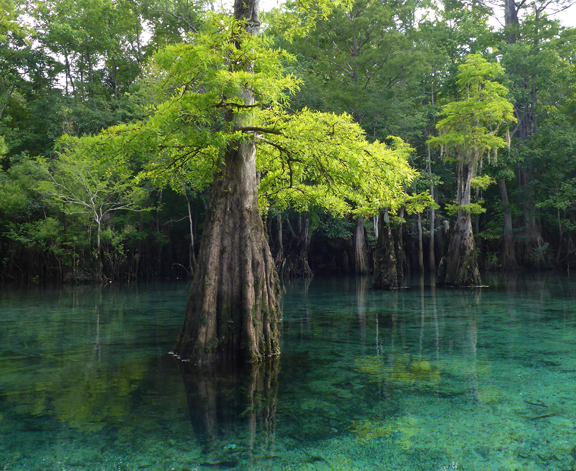 ACCESS BY PADDLING OR VEHICLE. Just south of Ponce De Leon, the 161-acre park is well known in the area, and popular with divers and nature enthusiasts across the south. Cypress trees abound around the spring with their crisp, bright green needles defining the landscape. The spring provides an aqua color inviting everyone in for a dip.
ACCESS BY PADDLING OR VEHICLE. Just south of Ponce De Leon, the 161-acre park is well known in the area, and popular with divers and nature enthusiasts across the south. Cypress trees abound around the spring with their crisp, bright green needles defining the landscape. The spring provides an aqua color inviting everyone in for a dip.
The highlight of the park is a 250-foot diameter spring pool that produces an estimated 48 million gallons of crystal clear water each day and has been recorded to produce up to 70 million gallons a day. Three cavities allow Morrison’s frigid waters to surface from the underground aquifer. The deepest of these cavities, at approximately 300 foot in depth, eventually terminates in an underground chamber of unknown dimensions. Morrison Springs is a favorite of divers.
575 linear ft. of boardwalks meander through the ancient cypress trees, and span into the springs to a diver’s launching area, with a 10×10 ft. 9,000 lb. floating concrete platform.
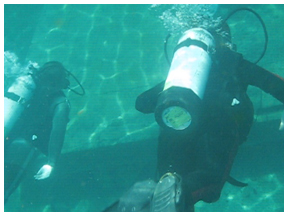
Restroom facilities, a pavilion with picnic area, wash stations, showers and handicap access are available at the park now, offering it the perfect family destination.
There are 72 parking spaces at the entrance to the park, which include 10 bus and 4 handicap spaces. There are 24 boat/trailer spaces located at the boat ramp.
The park was acquired by the state in 2004 and its management is now entrusted to Walton County for 99 years. The project is also part of the ‘DEP Springs Initiative;’ a comprehensive protection effort which provides funding for springs restoration throughout the state of Florida.
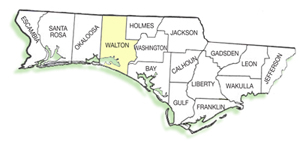
Directions:
Morrison Springs is located in the most southeastern part of Ponce deLeon just inside the Walton County line. From Freeport, take State Road 20 east to State Road 81 and go north past Red Bay to County Highway 181C. Turn right and continue 1.6 miles. Turn a right on Morrison Springs Road. This is a County park there are no fees. Open from 8 a.m. – sunset.
________________________________________________________
Ponce deLeon Springs State Park in Holmes County
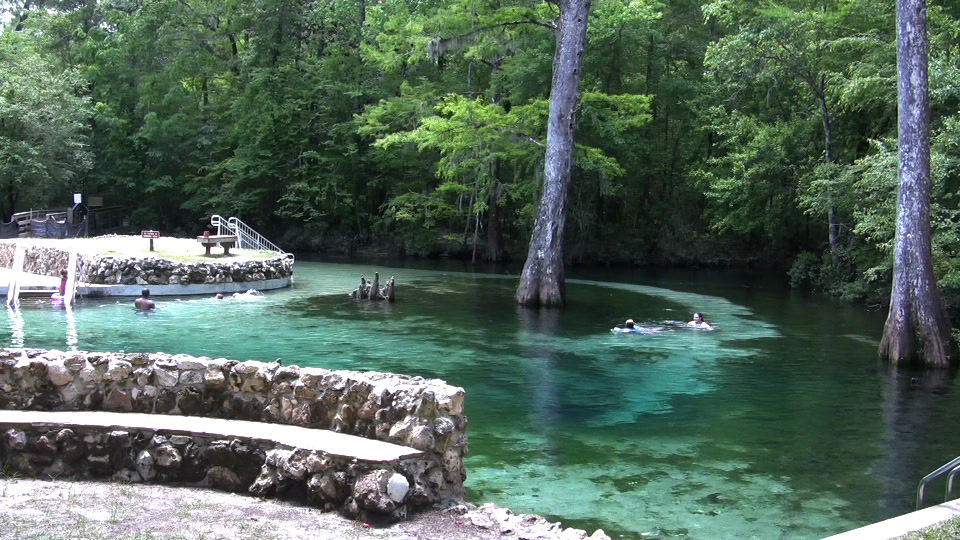
ACCESS BY VEHICLE. Just outside the Walton County line is one of the coolest places to take a dip in a spring, Ponce de Leon Springs State Park. As the water stays a constant 68 degrees Fahrenheit year-round, both locals and visitors enjoy this nature-made swimming pool, which is a convergence of two underground water flows, producing 14 million gallons of water daily.
The main vent is centrally located in the pool at a depth of 16 feet and is about 9 feet in diameter. A second vent about 10 feet from the north bank is a circular chimney 6 to 8 feet in diameter with a depth of 16 feet. A few feet from the north bank near the spring-run is a third vent. The aquatic cave habitat has been greatly improved because of recent efforts to remove organic sediments and debris that had previously blocked the vents. The park’s aquatic cave is likely home to cave crayfish.
This beautiful spring is named for Juan Ponce de Leon, who led the first Spanish expedition to Florida in 1513 – as legend has it, in search of the “fountain of youth.”
The park has a long history as it has been facilitated as far back as the early 1900s, and at one time, offered a roller skating rink. The State acquired the springs in 1970.
The spring area boasts an open pool with easy access steps entering the water. The crystal clear water shows bream and bass swimming around below.
Visitors can take a leisurely walk along two self-guided nature trails through a lush, hardwood forest and learn about the local ecology and wildlife. The walk offers a closer look at Sandy Creek, where the springs empties into, and eventually leads to the Choctawhatchee River.
Local flora includes mountain laurel, magnolias, cypress, holly, cedar and oak trees. Snakes, fox, and lizards are a common sight in the area as well.
There are four pavilions offering grills and picnic tables. There are several more tables and grills scattered around the park offering the perfect place to hold a family picnic. Rangers also conduct seasonal guided walks, and anglers can enjoy fishing for catfish, largemouth bass, chain pickerel and panfish.
Hours of Operation
8 a.m. to sunset
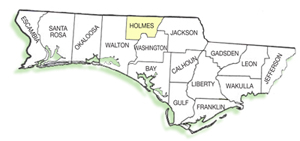
Driving Directions:
Ponce de Leon Springs State Park Area is located one half mile south of U.S. 90 on C.R. 181A in Ponce de Leon, Fla.
Park Fees:
Admission Fee – $4.00 per vehicle.
Pedestrians, bicyclists, extra passengers, passengers in vehicles with holder of annual individual entrance permit – $2.00
Ponce de Leon Springs State Park
2860 Ponce de Leon Springs Road
Ponce de Leon, Florida 32455
Phone: 850-836-4281
________________________________________________________
Paddle, swim, fish or cave dive at Merritt’s Mill Pond in Marianna
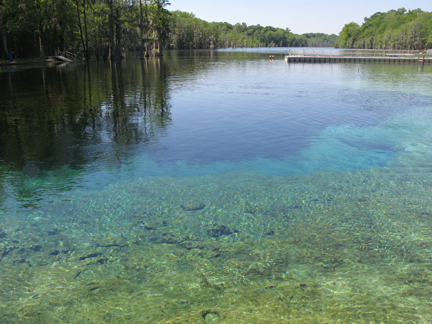
Self guided
ACCESS BY PADDLING OR VEHICLE. What do Jackson Blue, Shangri-la, Twin Caves, Indian Wash Tub, Hole-in-the-Wall, Gator Hole, and Hidey Hole have in common? They are all names of springs feeding into the crystal clear waters of beautiful Merritt’s Mill Pond in Jackson County.
Located just east of Marianna, Merritt’s Mill Pond is actually a 202-acre reservoir fed mostly by one spring named Blue Spring or Jackson Blue. Considered to be one of the most beautiful springs to explore by divers, Jackson Blue’s main vent is a limestone cave close to 5,000 ft. in length. It is a first magnitude spring, discharging an average of about 76 million gallons a day, and is the head waters of Merritt’s Mill pond.
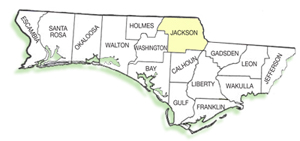
Several smaller springs feed into the four-mile long pond, creating a haven wildlife viewing as you explore on your kayak, canoe, stand up paddle board or boat. Towering stands of cypress trees draped with Spanish moss are scattered throughout the pond along with oak leaf hydrangea and ferns dotting the limestone rocks along the banks. A variety of birds can be viewed such as herons, cormorants, ibis, kingfisher and cave dwelling black vultures. Turtles are a common sight as they often sunbathe on old floating logs.
